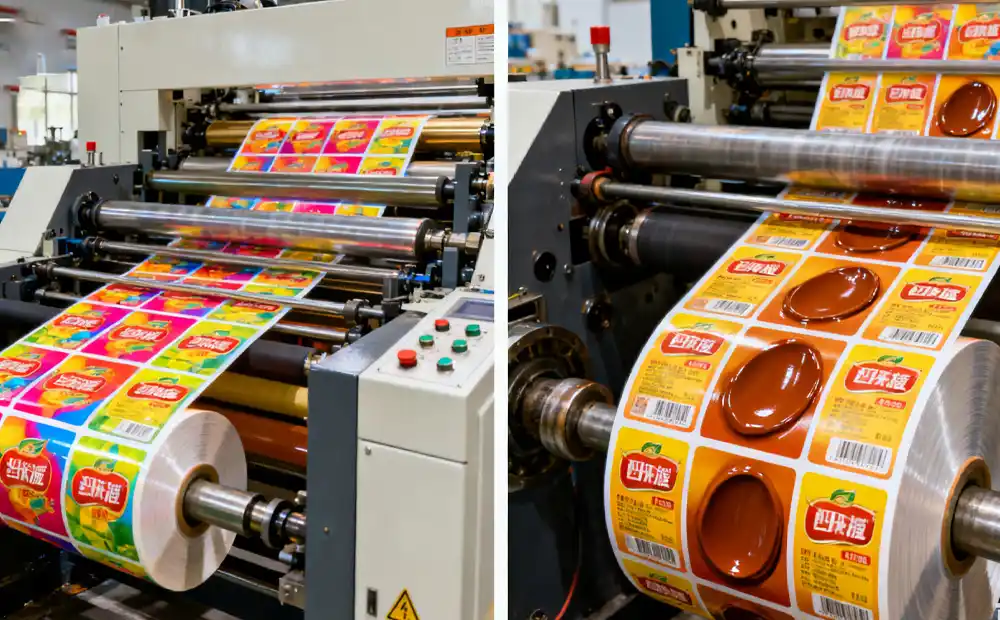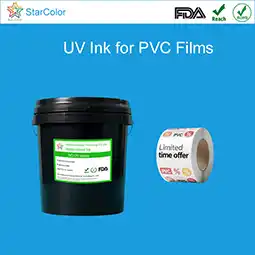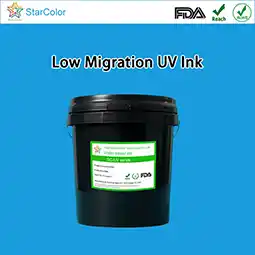Is flexographic or gravure used for label printing
Date: Jul 16 2024 From: Star Color Views:
Flexographic printing and gravure printing are the two mainstream technologies in label production. The former is known for its eco-friendliness and efficiency, while the latter excels in high precision. However, many companies face misconceptions when choosing between the two, often leading to mismatched applications.
Industry statistics show that around 30% of label printing quality issues are linked to process mismatch—for example, using flexo to print high-precision halftone labels results in blurriness, while gravure for small batches leads to unnecessary costs. This article compares flexo and gravure across three dimensions—technical characteristics, application scenarios, and cost efficiency—to provide a scientific basis for decision-making.
1. Technical Characteristics
The fundamental difference between flexographic and gravure printing lies in the plate structure, ink transfer method, and curing principle. These directly affect print precision, environmental performance, and substrate adaptability.
Flexographic Printing – More Eco-Friendly
Flexo uses elastic relief plates (usually photosensitive resin, hardness 250–400) and anilox rollers for ink transfer. Inks are typically water-based or UV-curable.
Key advantages:
-
Eco-Friendly: Water-based flexo inks have VOC content ≤50 g/L, and UV flexo inks release nearly zero VOCs. They meet international environmental standards and eliminate the need for costly VOC treatment systems.
-
Wide Substrate Range: Suitable for BOPP, PET, PE films, coated papers, kraft papers, foils, and pressure-sensitive labels—without frequent plate changes.
-
Lower Costs: Flexo plate-making takes 1–2 days and costs about $0.04 per cm², while press investment is 30–50% lower than gravure, making it ideal for small to medium runs.
Drawbacks:
-
Limited dot reproduction accuracy: 50% dot gain often exceeds 15%. Fine text (<2 pt) may show edge roughness.
-
Thin ink layer (1–3 μm): Large solid areas may suffer from “show-through.”
Gravure Printing – Higher Precision
Gravure uses engraved metal cylinders (copper or chrome-plated) with ink volume controlled by cell depth. Inks are often solvent-based or UV-curable.
Key advantages:
-
High Precision: Achieves sharp halftone dots with ≤8% dot gain. Fine lines (0.1 mm) and gradient designs are reproduced clearly, ideal for premium security labels.
-
Thicker, Uniform Ink Layers: 3–8 μm thickness delivers rich, saturated colors, excellent metallic/pearlescent effects, and 50% better abrasion resistance than flexo.
-
Superior Stability: Gravure cylinders are highly durable. In mass production, color deviation is kept under ΔE ≤ 0.5, perfect for standardized large runs.
Drawbacks:
-
High VOC Emissions: Solvent-based gravure inks require RTO incineration, adding environmental costs.
-
High Plate & Equipment Costs: Cylinder engraving takes 5–7 days and costs 4–5 times more than flexo plates. Equipment investment is also significantly higher, making it inefficient for small runs.

2. Application Scenarios
The right choice depends on application context—there is no absolute winner, only the best match for the job.
When to Choose Flexo Printing
-
Small to Medium Runs (<500,000 labels): e.g., cosmetics trial packaging or seasonal promotions. Flexo plates are cheaper and faster to replace.
Example: A cosmetics brand printing 100,000 trial-size labels saved 80% on plate-making costs and shortened lead time by 5 days using flexo instead of gravure. -
Eco-Sensitive Industries: Food and pharma labels benefit from water-based flexo inks that comply with FDA 21 CFR and EU 10/2011 migration standards.
-
Mixed Substrate Jobs: Orders involving both PE films and kraft paper are more efficient with flexo—no press change is needed, only anilox adjustments, improving efficiency by 40%.
-
General Labels: Logistics or appliance labels, where precision requirements are modest (≤120 lpi), are best suited for flexo.
When to Choose Gravure Printing
-
Large Runs (>1 million labels): e.g., beverage bottle labels or battery labels. Gravure’s durability lowers unit costs at scale.
Example: A beverage company printing 100 million labels annually saved $200,000 per year with gravure compared to flexo due to lower per-unit costs. -
High-End Labels: Luxury cosmetics, alcohol, or anti-counterfeit labels requiring ≥200 lpi and metallic gradient effects perform better with gravure.
-
Thick Ink Layer Needs: Night-glow or tactile labels require 5–8 μm layers, which gravure achieves while flexo cannot.
-
Strict International Standards: Some Western markets demand ΔE ≤ 0.3 color consistency, easier to achieve with gravure.
3. Cost and Efficiency
From a long-term perspective, choosing between flexo and gravure should consider equipment investment, consumable costs, and production efficiency.
Cost Comparison (Annual Output: 5 million PET labels)
| Cost Item | Flexographic Printing | Gravure Printing | Difference |
|---|---|---|---|
| Equipment | ~$300,000 (6-color) | ~$1.5 million (6-color) | Gravure 5× higher |
| Plates/Cylinders | ~$1,600 (4 sets) | ~$8,000 (4 cylinders) | Gravure 5× higher |
| Ink Costs | ~$11,000 (water-based) | ~$17,000 (solvent-based + treatment) | Gravure ~50% higher |
| Annual Total | ~$50,000 | ~$115,000 | Flexo saves ~56% |
When output rises to 20 million labels annually:
-
Flexo total: ~$170,000
-
Gravure total: ~$310,000
→ Cost gap narrows to 45%. Gravure’s lower waste rate (1.2% vs. flexo’s 2.5%) further balances costs.
Efficiency Comparison
-
Speed: Flexo runs 200–300 m/min; gravure 250–400 m/min. Gravure is slightly faster, but flexo changeovers (1–2 hrs) are much quicker than gravure (4–6 hrs).
-
Lead Time: For small runs (<500,000), flexo delivery is 3–5 days vs. 7–10 days with gravure. For large runs (>2 million), gravure is faster by 1–2 days due to higher stability.
Conclusion: No “Best,” Only “Best Fit”
Flexographic and gravure printing are not in direct competition but rather complement each other.
-
Flexo = Cost-Performance King: Best for small/medium runs, eco-sensitive packaging, and multi-substrate jobs.
-
Gravure = Quality King: Best for large-scale, high-precision, or thick-ink applications.
Instead of chasing one technology, companies should match printing methods to product positioning, production scale, and regulatory requirements. Only by making scenario-based decisions can businesses achieve both quality and cost efficiency in label printing.
 RU
RU EN
EN CN
CN















